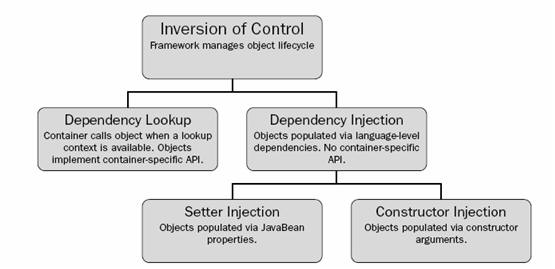最近公司需要,項目中要用到Spring和Ibatis。趁著過年好好學(xué)習(xí)學(xué)習(xí)。Ibatis就如同Hibernate一樣的持久層技術(shù),學(xué)習(xí)起來難度不大,但Spring可不一樣,揣著Ioc,DJ和AOP,四處走紅。學(xué)起來可不容易。就市面上而言,就一本《expert one-on-one J2EE Development without EJB中文版》值得參考,為了生活,再貴也得買。這本書的前五章都是說EJB的不是,從第六章開始進入正題,介紹控制反轉(zhuǎn),以后基本都是說Spring了。
可能本人比較愚笨,控制反轉(zhuǎn)弄得不明白。這樣就得上網(wǎng)上找答案了。最后在一個叫Bromon的blog上找到的淺顯易懂的答案。下面就是引用他說的話:
IoC與DI
首先想說說IoC(Inversion
of Control,控制倒轉(zhuǎn))。這是spring的核心,貫穿始終。所謂IoC,對于spring框架來說,就是由spring來負責(zé)控制對象的生命周期和
對象間的關(guān)系。這是什么意思呢,舉個簡單的例子,我們是如何找女朋友的?常見的情況是,我們到處去看哪里有長得漂亮身材又好的mm,然后打聽她們的興趣愛 好、qq號、電話號、ip號、iq號………,想辦法認識她們,投其所好送其所要,然后嘿嘿……這個過程是復(fù)雜深奧的,我們必須自己設(shè)計和面對每個環(huán)節(jié)。傳 統(tǒng)的程序開發(fā)也是如此,在一個對象中,如果要使用另外的對象,就必須得到它(自己new一個,或者從JNDI中查詢一個),使用完之后還要將對象銷毀(比
如Connection等),對象始終會和其他的接口或類藕合起來。
那么IoC是如何做的呢?有點像通過婚介找女朋友,在我和女朋友之間引入了一個第三者:婚姻介紹所。婚介管理了很多男男女女的資料,我可以向婚 介提出一個列表,告訴它我想找個什么樣的女朋友,比如長得像李嘉欣,身材像林熙雷,唱歌像周杰倫,速度像卡洛斯,技術(shù)像齊達內(nèi)之類的,然后婚介就會按照我 們的要求,提供一個mm,我們只需要去和她談戀愛、結(jié)婚就行了。簡單明了,如果婚介給我們的人選不符合要求,我們就會拋出異常。整個過程不再由我自己控 制,而是有婚介這樣一個類似容器的機構(gòu)來控制。Spring所倡導(dǎo)的開發(fā)方式就是如此,所有的類都會在spring容器中登記,告訴spring你是個什 么東西,你需要什么東西,然后spring會在系統(tǒng)運行到適當(dāng)?shù)臅r候,把你要的東西主動給你,同時也把你交給其他需要你的東西。所有的類的創(chuàng)建、銷毀都由 spring來控制,也就是說控制對象生存周期的不再是引用它的對象,而是spring。對于某個具體的對象而言,以前是它控制其他對象,現(xiàn)在是所有對象 都被spring控制,所以這叫控制反轉(zhuǎn)。如果你還不明白的話,我決定放棄。
IoC的一個重點是在系統(tǒng)運行中,動態(tài)的向某個對象提供它所需要的其他對象。這一點是通過DI(Dependency Injection,依賴注入)來實現(xiàn)的。比如對象A需要操作數(shù)據(jù)庫,以前我們總是要在A中自己編寫代碼來獲得一個Connection對象,有了 spring我們就只需要告訴spring,A中需要一個Connection,至于這個Connection怎么構(gòu)造,何時構(gòu)造,A不需要知道。在系統(tǒng) 運行時,spring會在適當(dāng)?shù)臅r候制造一個Connection,然后像打針一樣,注射到A當(dāng)中,這樣就完成了對各個對象之間關(guān)系的控制。A需要依賴 Connection才能正常運行,而這個Connection是由spring注入到A中的,依賴注入的名字就這么來的。那么DI是如何實現(xiàn)的呢? Java 1.3之后一個重要特征是反射(reflection),它允許程序在運行的時候動態(tài)的生成對象、執(zhí)行對象的方法、改變對象的屬性,spring就是通過反射來實現(xiàn)注入的。關(guān)于反射的相關(guān)資料請查閱java doc。
我想通過Bromon的介紹,大家對IoC和DI都有了比較生動的理解了。再來看看《expert one-on-one J2EE
Development without EJB中文版》是怎么解釋這兩個概念的。書上是這么說的:
IoC是一個很大的概念,可以用不同的方式來實現(xiàn)。主要的實現(xiàn)形式有兩種:
依賴查找:容器提供回調(diào)接口和上下文環(huán)境給組件。EJB和Apache Avalon都是使用這種方式。
依賴注入:組件不做定位查詢,只是提供普通的Java方法讓容器去決定依賴關(guān)系。容器全權(quán)負責(zé)組件的裝配,它會把符合依賴關(guān)系的對象通過JavaBean屬性或者構(gòu)造子傳遞給需要的對象。通過JavaBean屬性注射依賴關(guān)系的做法稱為設(shè)值方法注入(Setter
Injection);將依賴關(guān)系作為構(gòu)造子參數(shù)傳入的做法稱為構(gòu)造子注入(Constructor
Injection)。
附圖說明:

到這里,大家應(yīng)該對IoC與DI都有了初步的認識了。其實就Spring來說,就是JavaBean由Spring來管理組裝,表面上看就少了幾個new字,其實就是為了降低耦合度,這也是我們做軟件的目標之一。
至于Spring是怎樣實現(xiàn)IoC的,《expert
one-on-one J2EE Development without EJB中文版》第七章“Spring框架介紹”很詳細的列舉了多種方法。說實在,一下子看這么多,我真有點糊涂了。我還是自己寫個Demo熟悉一下大名鼎鼎的Spring吧。
首先得下載Spring。Spring網(wǎng)上有兩種Spring
包一種是spring-framework-
下載下來,解壓后,你會發(fā)現(xiàn)里面有很多jar文件。因為剛剛接觸Spring,因此我只需要spring-core.jar(spring-framework-
準備就緒,開始寫Demo了。
我的工程的結(jié)構(gòu)是:

1、 log4j.properties代碼:
log4j.appender.stdout=org.apache.log4j.ConsoleAppender
log4j.appender.stdout.layout=org.apache.log4j.PatternLayout
log4j.appender.stdout.layout.ConversionPattern=%c{1} - %m%n
如何使用Log4j,請看我的另一篇轉(zhuǎn)貼的文章:如何使用Log4J。
2、 HelloBean的代碼:
public class HelloBean {
private String helloworld="Hello!World!";
public String getHelloworld() {
return helloworld;
}
public void setHelloworld(String helloworld) {
this.helloworld = helloworld;
}
}
這是一個簡單的JavaBean,有個String類型的helloworld屬性,初始值是"Hello!World!"。
3、 Bean.xml代碼:
<!DOCTYPE beans PUBLIC "-//SPRING/DTD BEAN/EN"
"http://www.springframework.org/dtd/spring-beans.dtd">
<beans>
<bean id="helloBean" class="com.HelloBean">
<property name="helloworld">
<value>Hello!Rick</value>
</property>
</bean>
</beans>
Spirng重點之一就是配置文件,上面是個相當(dāng)簡單的配置文件,我想大家都應(yīng)該看得懂。最后就是寫應(yīng)用程序了。
4、 Test的代碼:
import org.springframework.beans.factory.*;
import org.springframework.beans.factory.xml.XmlBeanFactory;
import org.springframework.core.io.ClassPathResource;
import org.springframework.core.io.Resource;
public class Test {
public static void main(String[] args) {
//實例化JavaBean,主要是為了比較new對象和依賴注入兩者的區(qū)別
HelloBean hellobean=new HelloBean();
System.out.println(hellobean.getHelloworld());
//通過Spring訪問JavaBean組件
Resource resource=new ClassPathResource("com/bean.xml");
BeanFactory factory=new XmlBeanFactory(resource);
hellobean=(HelloBean)factory.getBean("helloBean");
System.out.println(hellobean.getHelloworld());
}
}
Spring的依賴注入相對復(fù)雜一點,主要是明白調(diào)用別的Bean,不是通過實例化對象來調(diào)用,而是告訴Spring,我需要什么Bean,然后Spring再向你的Bean里面注入你所需要的Bean對象。
接下來說說代碼實現(xiàn),我只是在剛剛的例子上再添加一點東東。
首先要增加一個HelloImp的接口,這是問什么呢,那你得問Spring,它定的規(guī)矩:JavaBean的實現(xiàn)要有兩個部分,一個接口,一個默認實現(xiàn)。你不照做就不行。
HelloImp代碼:
public interface HelloImp {
public void getName();
}
實現(xiàn)HelloImp的Hello代碼:
public class Hello implements HelloImp {
public void getName(){
System.out.println("Jack");
}
}
接著就是在HelloBean中調(diào)用Hello了。Spring的不同之處也在這體現(xiàn)出來。
public class HelloBean {
private String helloworld="Hello!World!";
private HelloImp hello; //注意這個私有對象是借口
public String getHelloworld() {
return helloworld;
}
public void setHelloworld(String helloworld) {
this.helloworld = helloworld;
}
public void setHello(HelloImp hello) {
this.hello = hello;
}
public void get(){
this.hello.getName();
}
}
配置文件也需要增加一點東西:
<!DOCTYPE beans PUBLIC "-//SPRING/DTD BEAN/EN"
"http://www.springframework.org/dtd/spring-beans.dtd">
<beans>
<!—注意引用的類是具體的類Hello-->
<bean id="myHello" class="com.Hello">
</bean>
<bean id="helloBean" class="com.HelloBean">
<property name="helloworld">
<value>Hello!Rick</value>
</property>
<property name="hello">
<ref bean="myHello"></ref>
</property>
</bean>
</beans>
注意字體加粗的部分。
最后在Test中添加一句hellobean.get();就可以看到結(jié)果了。
import org.springframework.beans.factory.*;
import org.springframework.beans.factory.xml.XmlBeanFactory;
import org.springframework.core.io.ClassPathResource;
import org.springframework.core.io.Resource;
public class Test {
public static void main(String[] args) {
HelloBean hellobean=new HelloBean();
System.out.println(hellobean.getHelloworld());
Resource resource=new ClassPathResource("com/bean.xml");
BeanFactory factory=new XmlBeanFactory(resource);
hellobean=(HelloBean)factory.getBean("helloBean");
System.out.println(hellobean.getHelloworld());
hellobean.get();
}
}
到這,Spring的IoC和DI總算有了一定的認識,也算是敲開了Spring的大門了。





